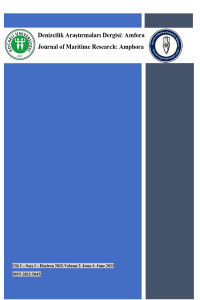Türk Ticaret Filosunun Gelişimi Üzerine Gemi Cinslerini Temel Alan Regresyon Analizi
Küresel ticaretin önemli bir kısmı deniz yoluyla yapıldığından, denizcilik endüstrisindeki büyük ölçekli yatırımlar ve iyileştirmeler uluslararası bir etkiye sahip olacaktır. Deniz taşımacılığı operasyonlarında kayıtlı gemi sayısı ve elleçlenen yük açısından Çin, Yunanistan, Singapur ve Japonya gibi önemli ülkeler olmakla birlikte, Türkiye'nin deniz filosu oldukça fazla sayıda gemiye ve gemi hareketlerine sahiptir. Bu çalışmada Türk ticaret filosunun gemi cinsleri, sayıları ve DWT değerleri yıllık olarak ayrıntılı bir şekilde incelenmekte ve uluslararası verilerle karşılaştırmalar yapılmaktadır. Türk ticaret filosunun trendini analiz etmek amaçlı, 150 GT ve üzeri filoya ait gemiler cinslerine göre DWT ve adet temelinde incelemekte, oransal değişimler belirtilmekte ve gelecek yıllar için tahminlerde bulunulmaktadır. Tahmin etme aşamasında doğrusal regresyon analizi 13 farklı gemi tipi üzerinde uygulanmakta ve gelecek üç yıl için değerlendirmeler yapılmaktadır. Bulgulara göre hem DWT hem adet açısından en güvenilir tahminler kuru yük gemilerinde ve dökme yük gemilerinin verileri üzerinden yapılmaktadır. Buna karşın analiz sonucunda ham petrol tankerleri ve ticari yatlarla herhangi bir trend yakalanamamıştır.
Anahtar Kelimeler:
Gemi cinsi, DWT, doğrusal regresyon analizi, ticaret filosu
Regression Analysis Based on Ship Types on the Development of the Turkish Commercial Fleet
Large-scale investments and improvements in maritime industry will have an international impact since sizable portion of global trade is conducted by sea. Although there are important countries such as China, Greece, Singapore and Japan in terms of the number of registered ships and the cargo handled in maritime transport operations, Turkey's marine fleet has a sizable number of ships and ship movements. The Turkish merchant fleet's ship types, numbers, and DWT values are elaborately reviewed annually in this paper, and comparisons with international data are performed. In order to analyze the trend of the Turkish merchant fleet, ships of 150 GT and higher are analysed based on DWT and the number of types, proportional changes are noted, and forecasts are performed upcoming years. In the forecasting phase, linear regression analysis is applied on 13 different ship types and evaluations are carried out for the next three years. The results show that dry cargo ship and bulk carrier data provide the most accurate estimations for both DWT and the number of ships. On the other hand, none of trend could be detected with the analysis crude oil tankers and commercial yachts as a result of the analysis. The yearly addition of new data will make it possible to compare the high-confidence trends found in the study and the revealing of the actual reliability levels.
___
- Bruce, G. J. and Eyres, D. J. (2012). Ship construction. Butterworth-Heinemann. Chatterjee, S. and Simonoff, J. S. (2013). Handbook of regression analysis. John Wiley & Sons. Denizcilik Genel Müdürlüğü (DGM). (2021). Deniz Ticareti İstatistikleri. Erişim Adresi: https://denizcilik.uab.gov.tr/uploads/pages/yayinlar/deniz-ticaret-istatistikleri-2020-61bc3b7e3c012.pdf. (15.10.2022).
- Denizcilik Genel Müdürlüğü. (2022). Deniz Ticareti İstatistikleri. https://denizcilik.uab.gov.tr/uploads/pages/yayinlar/istatistik-bulteni-2021-22-02-2022.pdf. (15.10.2022).
- International Maritime Organization (IMO). (2022). Introduction to IMO. Erişim Adresi: https://www.imo.org/en/About/Pages/Default.aspx#:~:text=Its%20main%20role %20is%20to,universally%20adopted%20and%20universally%20implemented. (15.10.2022). Manea, M. G., Zăgan, R., and Manea, E. (2020). Modelling of maritime ship repairs processes in shipyards, using the linear regression and correlation theory. In IOP Conference Series:Materials Science and Engineering Vol. 916, No. 1, p. 012063. IOP Publishing. Montgomery, D. C., Peck,
- E. A., and Vining, G. G. (2021). Introduction to linear regression analysis. John Wiley & Sons.
- Moscoso-López, J. A., Urda, D., Ruiz-Aguilar, J. J., Gonzalez-Enrique, J., and Turias, I. J. (2021). A machine learning-based forecasting system of perishable cargo flow in maritime transport.
- Neurocomputing, 452, 487-497. Paolella, M. S. (2018). Linear models and time-series analysis: regression, ANOVA, ARMA and GARCH. John Wiley & Sons. Plaza-Hernández, M., Gil-
- González, A. B., Rodríguez-González, S., Prieto-Tejedor, J., and Corchado-Rodríguez, J. M. (2020, June). Integration of iot technologies in the maritime industry. In International Symposium on Distributed Computing and Artificial Intelligence (pp. 107-115). Springer, Cham.
- T.C. Ulaştırma ve Altyapı Bakanlığı (UAB). (2019). Dünya Deniz Ticaret Filosu İlk 30 Ülke. Erişim Adresi: https://denizcilik.uab.gov.tr/deniz-ticareti-gostergeleri. (11.9.2022).
- T.C. Ulaştırma ve Altyapı Bakanlığı (2021). Türkiye’nin Denizyolu Verileri. Erişim Adresi: https://denizcilik.uab.gov.tr/deniz-ticareti-gostergeleri. (13.9.2022).
- T.C. Ulaştırma ve Altyapı Bakanlığı (2022). Filo İstatistikleri. Erişim Adresi: https://denizcilikistatistikleri.uab.gov.tr/filo-istatistikleri. (28.10.2022). Tsiotas, D., ve Polyzos, S. (2015). Analyzing the maritime transportation system in Greece: a complex network approach. Networks and Spatial Economics, 15(4), 981-1010.
- UNCTAD. (2021a). Review of Maritime Transport 2021. Erişim Adresi: https://unctad.org/system/files/official-document/rmt2021_en_0.pdf. (22.10.2022). UNCTAD. (2021b). Handbook of Statistics 2021. Erişim Adresi: https://unctad.org/system/files/official-document/tdstat46_en.pdf. (19.10.2022). Ünsan, Y., İnsel, M., ve Helvacıoğlu, İ. H. (2007). Dünya Deniz Ticareti ve Gemi Filosu Analizi.
- Wilmsmeier, G. and Martinez-Zarzoso, I. (2010). Determinants of maritime transport costs–a panel data analysis for Latin American trade. Transportation Planning and Technology, 33(1), 105-121.
- Başlangıç: 2022
- Yayıncı: Kocaeli Üniversitesi
Sayıdaki Diğer Makaleler
Güneyhan TOL, İpek ÇAĞLAYAN SARMAN, İsmet TIKIZ, Cenk ÇELİK
Deniz Yolu Taşımacılığında Freight Forwarder Firmalarının Yaşadığı Sorunlar Üzerine Bir Çalışma
Ali Umut UNAL, Ozan Hikmet ARICAN, Osman ARSLAN
Türk Ticaret Filosunun Gelişimi Üzerine Gemi Cinslerini Temel Alan Regresyon Analizi
Denizcilikte Emniyet Konusu İle İlgili Yapılmış Çalışmaların Bibliyometrik Analizi
